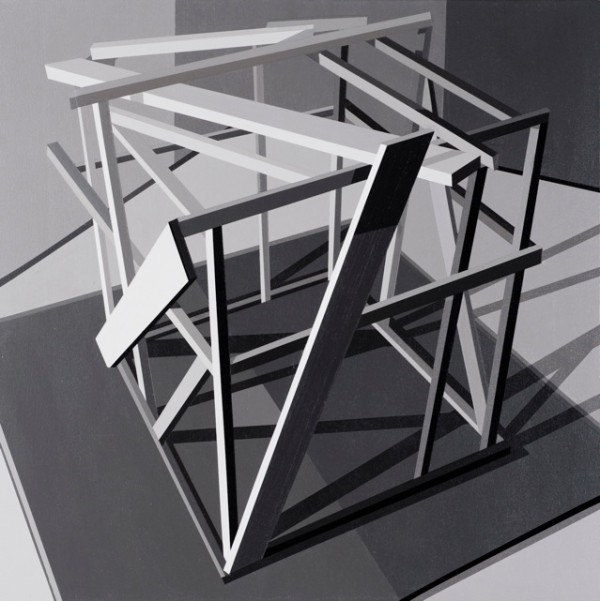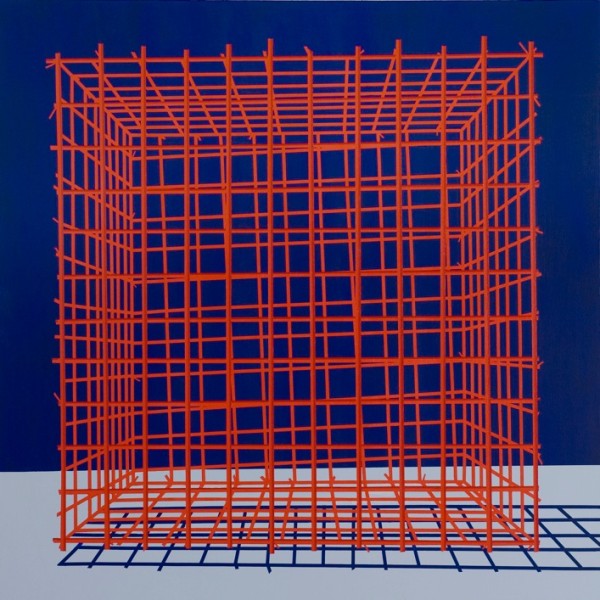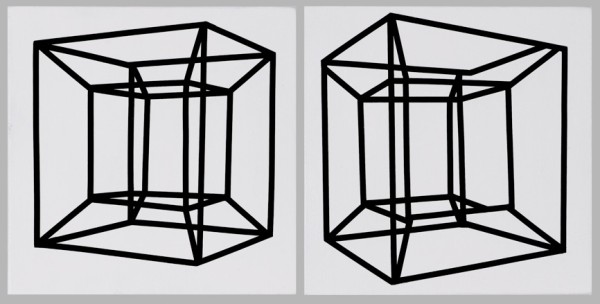
Ancient Practice of Painting
In his new show at Inman, Tommy Fitzpatrick continues to work in the precise, flat style he has used since the late 90’s to portray everything from mini-golf to road signs and architectural details, but moves away from large-scale objects to focus in on an eerie tabletop world of quasi-fantasy still lifes. Fitzpatrick’s highly abstracted photo-based work has always progressed less through stylistic innovation than through his choice of subject matter and, after a decade-long stint painting close-ups of glass and steel buildings , it’s exciting to see him strike off into new territory.
Through a methodical investigation of the possibilities of distilling photographic images into colorful, handsome hard-edge paintings, Fitzpatrick has finally reached a point where the existing world isn’t supplying suitable source material—the jumping-off point where many artists choose abstraction. But Fitzpatrick’s got a system that’s working for him. Rather than invent pictures of the funky, quasi-mathematical objects he’s interested in painting, which would be outside of his self-consistent rules, he has adopted a quirkily indirect, but completely obvious method: he invents the objects themselves, building them from scrap lumber, then paints pictures of them in his accustomed manner.
Ancient Practice of Painting, 2013, one of the show’s two best pieces, depicts a roughly cubical construction, set at an angle to the picture plane, almost like an isometric drawing. The tabletop it rests on is set at a similar (but not the same) angle in relation to the cube, creating a dynamic, twisting space that is reinforced by skewed wooden members in the construction. Exaggerated false colors and dead-flat paint application strain to flatten the image into a pattern of painted stripes, supplying the 2D-3D flipflop effect that has been Fitzpatrick’s signature shtick for the past fifteen years.

Flatland
Higher dimensions are creepy: the idea of unfelt, unseen planes of existence touching our own is like a campfire story told by PhD mathematicians. Flatland, 2013, the other standout painting in the show, has an appropriately haunted film noir ambience. As in Ancient Practice of Painting, a haphazard cubical construction rests on a tabletop but, instead of vivid colors, it’s entirely painted in shades of gray, with long twilight shadows. The skewed struts of the cube begin to look like ramshackle saloon doors in a western ghost town, or an apparatus left in a laboratory on a ruined planet.

Lineland
Other pieces in the show come up to Fizpatrick’s high technical standards, but don’t have the breakthrough oddness or the surprising pathos of Ancient Practice of Painting and Flatland. Reflection Into The Fourth Dimension, Right and Left, 2013, presents a pair of tesseracts, those slippery inside-out cubes that periodically appear on the covers of art ‘n’ math books. They combine apparent simplicity with a stubborn refusal to settle down into completely satisfying representations of three-dimensional objects, leaving the brain to niggle away at them endlessly, like an itch. Spaceland, 2013, a large faceted spheroid, an informal slouch to the left, like a thoughtful, if bloated, portrait head. Lineland, 2013, is an op-art lobster trap. Two shades of intense red gridlines vibrate against a deep blue background, forming a cubical energy cage that hovers slightly above a gray surface, as if it about to lift off. Tiny, untidy tag ends of red at the cube’s corners keep it anchored in reality; they could be the zip ties used to hold a wire construction together.
In Edwin Abbott’s 1884 book, Flatland, from which the show takes its title, the protagonist, “a humble square,” unsuccessfully seeks to enlighten other dwellers in his two-dimensional world about the possibility of a three-dimensional universe beyond their own, and ends up imprisoned for his heresy. The best of Fitzpatrick’s works shade simple perceptual curiosities with hints at lost innocence, broken futuristic ideals, and pathetic sympathy for mankind’s persistent yearning for transcendence, mathematical or otherwise.

Projection Into the Fourth Dimension, Right and Left



2 comments
The best Tommy Fitzpatrick paintings in recent years are those that skip past three dimensions and challenge the eye to make sense of the angles, connections, and shadows. Those are the paintings I can stand in front of all day and swap perspectives. It’s like watching a line become something, then revert back to simple line again… like watching barbed wire slide by in long loose strands out the window of a speeding truck, then turning it back to barbed wire in your mind.
Great show at the Inman, Tommy! Keep ’em coming.
Our conference center has a lovely Fitzpatrick piece in it. I always enjoy its symmetry when I go by.